UFC 291 Aftermath: What Made Gaethje So Effective Against Poirier
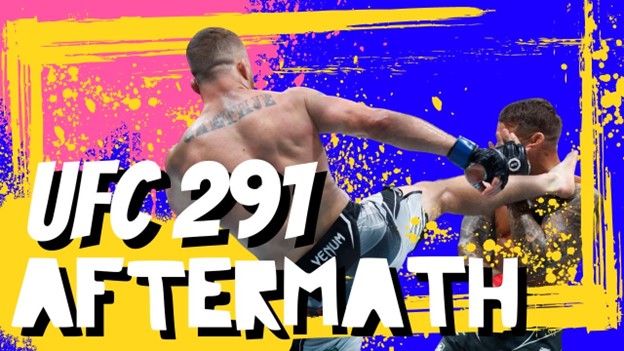
Blaine Henry/Sherdog.com illustration
UFC 291 delivered—and to cap things off, Justin Gaethje evened things up with Dustin Poirier by knocking him out in Round 2 with a spectacular high kick, avenging his loss from 2018. Gaethje has changed dramatically since that first fight and a lot of those changes were made specifically for this rematch. Today, we are getting down and nerdy with UFC 291 Aftermath!
Advertisement
Gaethje: Controlled Chaos
Before we get into the nuts and bolts of this fight, I want to address something that I overlooked in the UFC 291 Beforemath article: the elevation. This fight was in Salt Lake City, Utah which is 4,200 feet above sea level. Justin Gaethje trains with Trevor Wittman in Greeley, Colorado which is 4,600 feet above sea level. With oxygen levels lower at elevation, living and training at elevation makes so much of a difference in acclimatization and it seems Gaethje was always going to have the advantage in the cardio department. Poirier was getting tired quickly and could have been in a bad way should he not have gotten sparked by Gaethje. That said, Gaethje didn’t go out there to out-cardio Poirier. He fought smart, poised, and had an incredibly strong game plan that was going to win the fight for him at the end of the day.
In Beforemath, we said the biggest concern was Gaethje’s low kicks. We went in depth on how Poirier used Gaethje’s inside low kicks to counter with a cross and wobble Gaethje to ultimately finish him. To fix this, Gaethje didn’t only throw the inside leg kick. Instead, he threw high kicks, a teep to the body, and the outside low kick as well. The outside low kick turned out to be the bread and butter for Gaethje and he went to that well often.
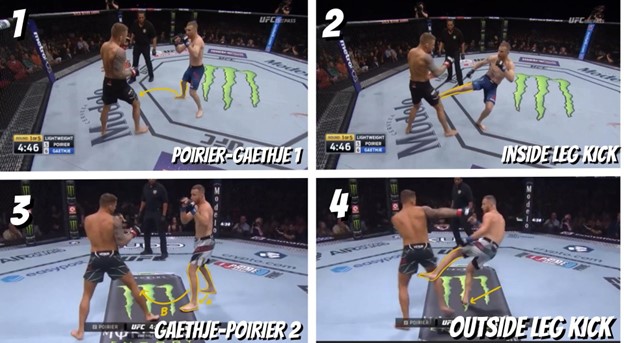
Blaine Henry/Sherdog.com illustration
In the figure above, I have the two fights between Gaethje and Poirier transposed next to each other. In 1 and 2, we see how Gaethje sets himself up by kicking the inside of the leg of Poirier with his rear leg. This opens up the cross as the kicking motion brings the hips squared and opens up the face as a counter target. In the second fight, frames 3 and 4, we see the outside low kick of Gaethje where he steps up with his rear leg to close the distance and kicks with the front leg. This puts his shoulder and body between Poirier and his chin, adding a layer of protection. Doing this isn’t as powerful but with Gaethje’s volume, it adds up anyway.
This was a brilliant adjustment by Gaethje and Wittman for this fight. Alexander Volkanovski has proven to be a wizard at this and routinely pulls off the same type of attack with great effect. Adding a hair of variety, not even that much, really changed the kicking game for Gaethje and let him score points for the entire fight.
Next, we will discuss the double jab utilized by Gaethje, another thing we brought up in Beforemath. Gaethje needed to back Poirier up and to do so, he could double up on the jab for extra distance coverage and then follow up with a cross as seen above. Adding a wrinkle to this, Gaethje also switched stances, a very Poirier-like thing to do, as he jabbed, changing where his power shot came from.
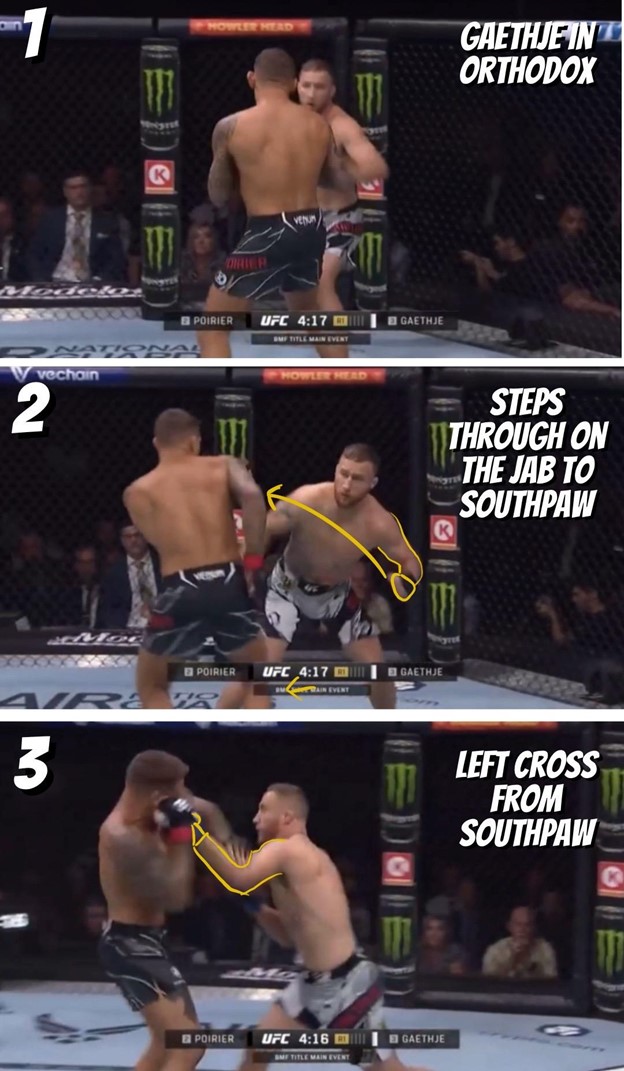
Blaine Henry/Sherdog.com illustration
When Poirier got Gaethje to the fence, he didn’t intend on staying there to get picked apart like Poirier likes to do. He wanted to get off the fence as far as possible. This instance, Gaethje, who is traditionally orthodox, (1) flicks out a cross/jab hybrid knowing Poirier would back away. As he steps forward again, (2) this time with his rear right leg, and into southpaw. The power hand that he just threw now becomes the jabbing hand and Gaethje throws it again. Poirier “nopes” on out of there and is leaning back. Gaethje would (3) follow up with the cross and almost land clean in this instance. Luckily for Poirier, he framed off the crossing arm with his shoulder roll and took a lot of the steam off the blow.
With Poirier jabbing so much, Gaethje also had to deal with that puzzle. He and Wittman knew that Poirier was often non-committal with the jab and flicked it out there, exposing Poirier and hurting his defensive shell.
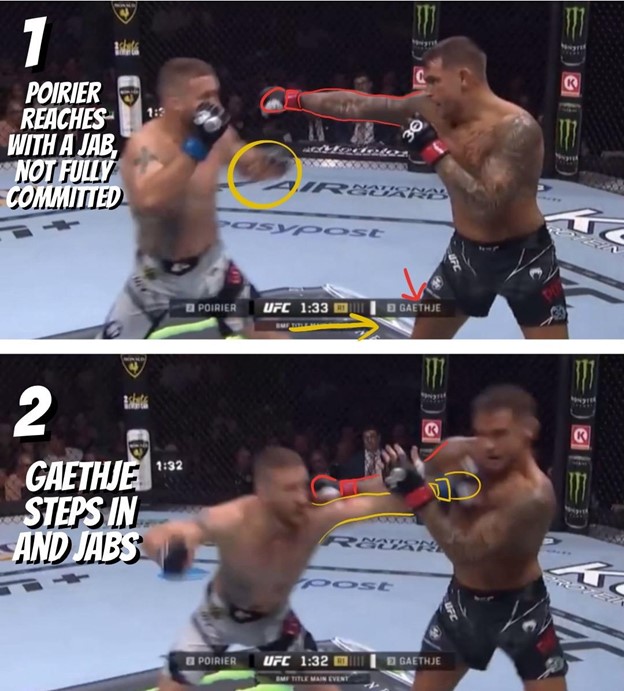
Blaine Henry/Sherdog.com illustration
To combat this, Gaethje was tasked with seeing which jabs Poirier just (1) flicked out as a poking, prodding weapon; the jabs where he didn’t step forward. There, Gaethje would (2) step in and under the jab to land a stiff jab of his own. Sticking Poirier like this repeatedly started to get Poirier to react to more and more of what Gaethje was throwing and this would play into the ending of the fight.
Showing Off Your Craftiness
There was a point in time where it looked like Gaethje had given up his wild man days and became a master tactician. James Vick, Donald Cerrone, Edson Barboza and Tony Ferguson found this out the hard way. Then, it seemed all regressed when he fought Khabib Nurmagomedov. There, he started brawling again like he’d never changed at all. Four ugly fights later and it seemed Gaethje would never change. We saw slivers of the change against Fiziev but nothing like we saw with Poirier in the rematch at UFC 291.
Part of this craftiness is what we managed to cover already, but he also showed some pretty new footwork. While Gaethje did fight a bit out of southpaw and Poirier does switch a fair amount, this is still a southpaw vs. orthodox matchup and Gaethje used it to his advantage.
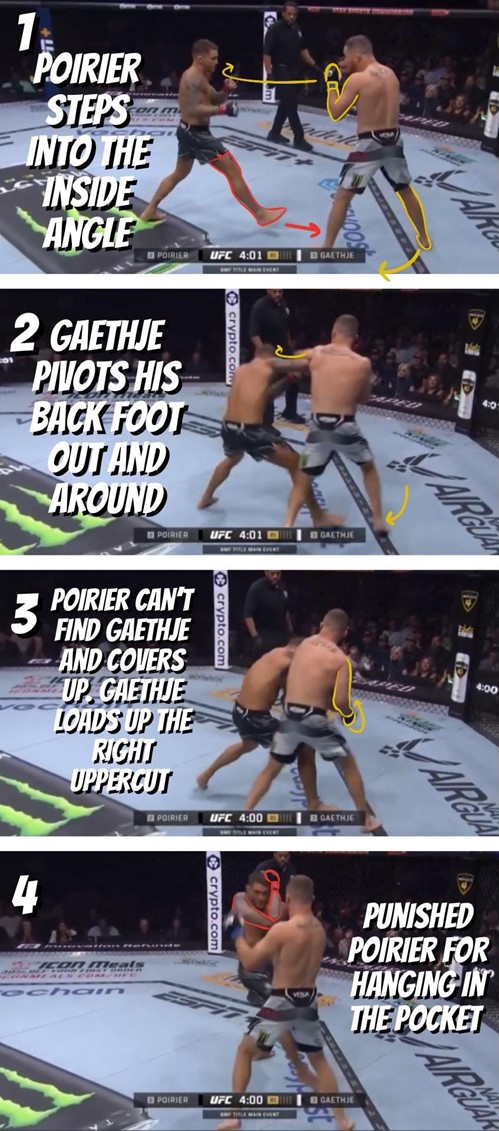
Blaine Henry/Sherdog.com illustration
Early in the fight, we see (1) Poirier stepping in to the inside angle of our southpaw versus orthodox matchup. While it’s commonly preached that you want the outside foot advantage, that is your lead foot on the outside of your opponent’s, stepping to the inside between your opponent’s two feet has its advantages too, which Manny Pacquiao is a wizard with. Truly there is not a right or wrong way to do this. Each has its advantages and each has its counters. Gaethje won this battle by knowing the counters better than Poirier. After Poirier stepped in, (2) Gaethje pivots his back foot around and knows he has the lead foot advantage. This creates the angle he wants and puts Poirier out of position. (3) Poirier no longer has the opponent in front of him as he expected and (4) Gaethje throws an uppercut. It’s these types of moves that Gaethje thrived on at UFC 291. He constantly circled out, stepped forward into southpaw, squared up, and a variety of other small things that Gaethje flummoxed Poirier with all fight and eventually led up to the finish.
In recent MMA meta, we’ve seen the cross to rear high kick became a sneakily deadly weapon. We saw that move by Leon Edwards dethrone Kamaru Usman, who is coincidentally a fighter under Wittman as well. It was this exact kick that Gaethje smashed Poirier with and ended the fight.
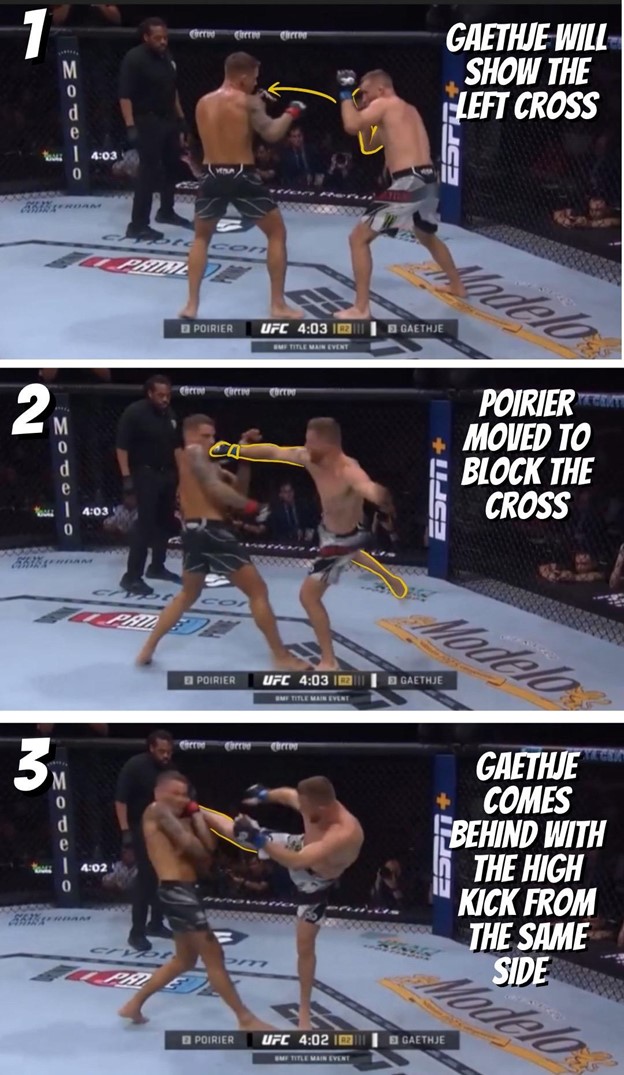
Blaine Henry/Sherdog.com illustration
In the diagram above, you can see Gaethje (1) leans to his right and loads a right cross up. (2) As he throws the cross into the face of Poirier, not entirely intending to make contact, Gaethje brings his rear leg up from the same side and Poirier is none the wiser. (3) Poirier is trying to swat down the cross coming his way and completely unaware of the roundhouse coming his way. When it lands, it’s all Gaethje needed and he took home the BMF title.
A second angle will give us a bit more insight on how this worked out so well.
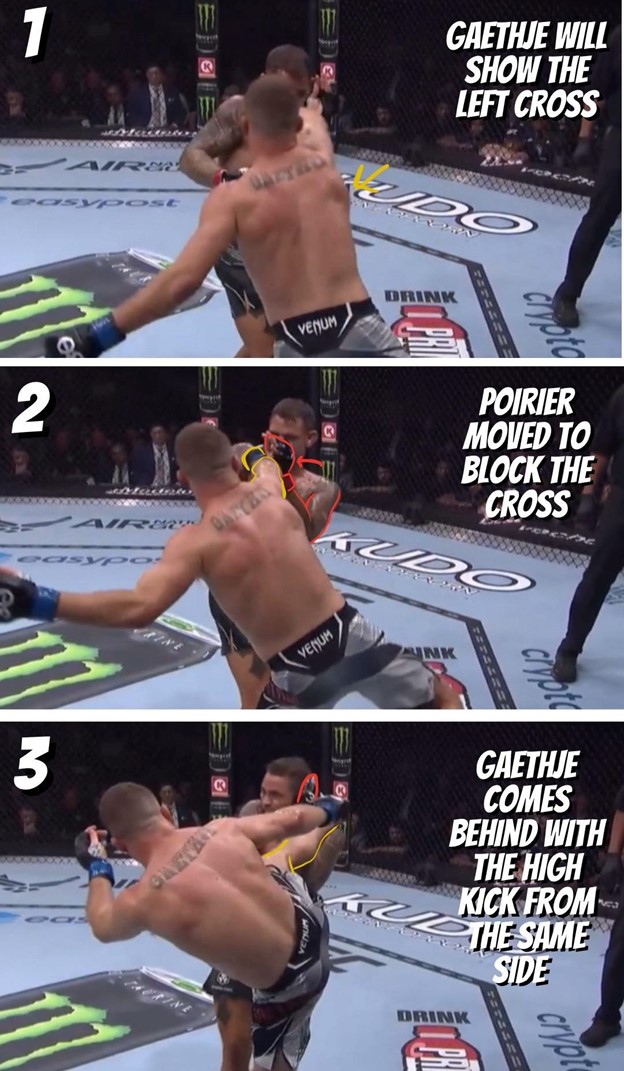
Blaine Henry/Sherdog.com illustration
Invisible in the first frame, we know (1) Gaethje is bringing his right arm across to blind Poirier. (2) As it almost lands notice where the left hand of Poirier is. It’s moving to meet the cross of Justin Gaethje. This is the same hand Poirier would try to block the kick with. In fact, twice in the first round he did just that. Although, Gaethje didn’t shoot the cross. When he does this time, Poirier is bringing that hand over to the cross and (3) by the time he susses the high kick out in time, he cannot get his hand back over in time. While he manages to partially block the kick, it’s not enough and down goes Poirier.
All in all, Gaethje’s changes made at UFC 291 were a step in the right direction. Wittman has made Usman and Rose Namajunas champions. You can rest assured he wants Gaethje to be a champion as well. With Islam Makhachev the king of the division, you can bet that Wittman had his eyes on the Volkanovski fight and a lot of these things we’ve seen against Poirier are likely from that. The switching stances, outside low kick, and doubling up on the jab are all straight out of the Aussie’s playbook. While Gaethje is nowhere near as polished as Volkanovski is, his unique skill set (Oppenheimer developed his hands in Los Alamos during the Manhattan Project) Gaethje doesn’t have to be. But adding these weapons into the arsenal will put him on closer to even footing against the Dagestani Dynasty. Will he be able to finally get over that one final hurdle and become undisputed lightweight champion?
« Previous Fight Facts: UFC 291 ‘Poirier vs. Gaethje 2’
Next Gaethje Turns Down McGregor’s Callout: ‘I’m Not Going to Fight Someone on Steroids’ »
More




 UFC News & Features
UFC News & Features

